Comparing Saucony vs Brooks running shoes will bring out a lot of similarities in these two competing brands, but there are some overarching fit and technology differences. Both brands provide high quality shoes and offer a variety of models to suit different needs from track spikes to marathon training shoes and trail running.
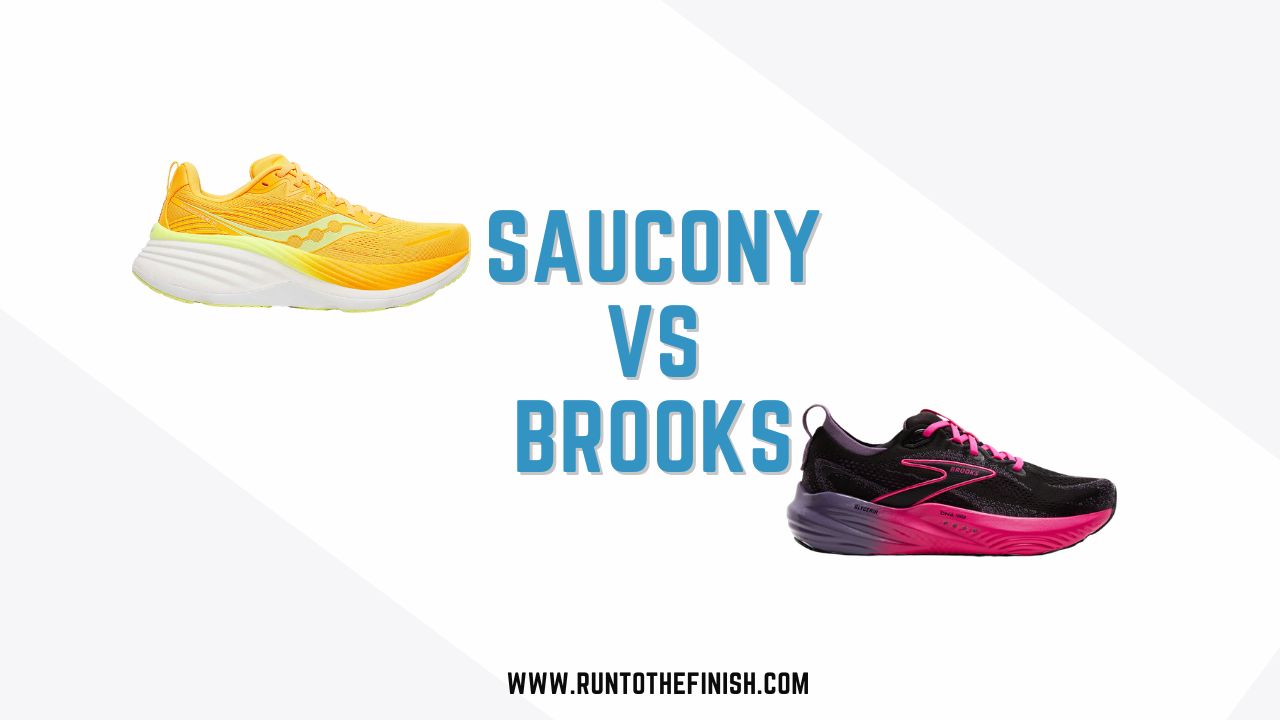
Saucony has made a splash in the last year with it’s new Endorphin collection. Really standing out as shift in technology and flashier marketing than we’ve seen from the brand, which alerted many runners to a brand they may have overlooked.
How do you say Saucony?
Since I used to get this question a ton wearing my Kinvaras, let me help you out.
Sock-a-knee.
It’s actually named after a creek in Pennsylvania and their logo is to represent the flow of water! They really love places for shoe names. I got to visit the actual towns of Kinvara and Kilkenny in Ireland, just a few of their shoe names.
Brooks vs Saucony Key Differences
Brooks and Saucony offer similar features and models for all kinds of runners, from the new runner to trail runner to the flat-footed or high-arched.
Largely, we’re looking at what makes these traditional running shoes different to see which might be a better fit for your training.
I break down the differences in more detail with specific shoe examples, but here’s a quick overview:
Brooks Running Shoes
- Wider Toe Box
- Exclusively designs running shoes
- Science-driven to accommodate rather than correct gait
Saucony Running Shoes
- Often noted as fitting a more narrow foot, with a smaller toebox
- Well known for the casual shoes as well as their running shoes
- Focus is on lighter shoes that provide maximum comfort
- Has an ongoing Fit Tester program to continually update shoes
I’ve worn both brands and will add some personal thoughts, along with links to detailed reviews. In fact, both brands are in my current shoe rotation.
Brooks vs Saucony Feature Comparison
Both brands have been around for a very long time and are leaders in running shoe design. They both offer various technologies to aid with comfort, support, stability, and cushion.
Where they differ most are in the fit and that Saucony is also well known for their casual classic shoes.
It’s gonna get a little TECHY…so you can just skip on down to the specific model comparison if you want, but personally if I’m shelling out $150 for shoes, I want to know why.
Durability
The lifespan of shoes from both companies is fairly comparable.
- Brooks shoes have a life expectancy ranging from 300 to 500 miles, or three to six months, depending on your monthly mileage.
- Saucony states their shoes last around 400 miles, which is pretty average. The new Endorphin pro with the carbon fiber plate is more like a racing shoe and therefore only expected to last around 200 miles.
Determining when to replace running shoes, of course, all depends on your gait, weight, and whether you run mostly on trail or road.
Fit
Brooks shoes have a wider toe box, which makes them a great choice for runners with wide feet or bunions. The brand recommends that buyers go up a half size from their everyday shoe.
Brooks does a great job with online fit, the Brooks shoe fit finder will give you an idea of what to look for in a running shoe when you do visit your local store.
Saucony has their own Shoe Advisor to help put you in the right model.
Their often lower heel to toe drop and cushion make them a favorite of distance runners, who find the decreased drop helps with issues like IT Band Syndrome and ensures they are working on hip strength over a shoe correcting a weakness.
Cushioning
Brooks uses two types of cushioning in their designs:
- DNA LOFT – Soft cushioning, that adapts to a runner’s profile, stride, and speed
- BioMoGo DNA – also adapts to runner’s profile, stride, and speed, providing a more balanced experience with a bit of spring.
Saucony has transitioned most of their shoes to PWRRUN technology, which they promote as a better than the standard EVA foam used by most brands.
- PWRRUN+ midsole cushioning provides more flexibility, durability, and springiness in a foam that’s 25% lighter
- Again and again their focus comes back to lighter, flexible for more power in your take off and more energy return
Stability
Brooks refers to individual running gaits as the “Run Signature.” Rather than “fix” the way someone runs, Brooks technology helps to stabilize your stride based on how you naturally run.
They put runners into two different categories: Neutral and Support.
Brooks GuideRails technology allows hips, knees, and joints to move naturally, offering support when needed. Neutral runners may only require them to kick in when their stride is off.
Saucony has also been transitioning to less aggressive stability tools, ensuring the shoe is not over correcting or doing the work for you.
They utilize a medial post (which is a device within the midsole that is firmer) to help provide control and a TPU heel plate which again makes the rides slightly firmer and adds control. Thanks to the cushioning, you don’t so much notice the stiffness and reap the benefits.
Affordability
The prices between the two brands are fairly comparable. Brooks prices range between $100 to $160, while Saucony starts at a slightly higher price at $110, averaging $149 for many models and then up to $249 for the Endorphin line.
You’ll notice that every brand offers a range and this is indeed due to a difference in technology and where they sell the shoe.
They know that the big box store can sell the shoe with less in it, while the local running store needs to be the best for dedicated runners. Having run in all the different things, I can 100% tell you it’s worth paying more for the better running shoe than what is at the box store.
Saucony Vs Brooks Running Shoe Models
Now that you know more about each brand, let’s look at their top models in each of the main categories. There’s no winner declared here because all are great shoes, it’s just about which one is best for your foot.
With each of these, they are the top models so numbers are constantly changing as they make a little upgrade and it becomes the Glycerin 22 or the Hurricane 24.
I was first introduced to Saucony with their original Kinvara in 2009. I stayed with that shoe for over 5 years, enjoying each new model and the fact that it made my IT band feel so much better.
BUTTTT….. I’ve also spent a lot of time in various Brooks models, so truly I like both brands for something different.
Stability Running Shoe
👉Brooks Adrenaline GTS 23
The brand’s most popular road running shoe (GTS stands for go-to-shoe) just turned 23 and comes in a swath of colors. This supportive shoe is best for a medium to high arch, and is part of the cushion line.
The Adrenaline is a support shoe offering GuideRails technology to prevent excess movement in your stride. They’re another extremely popular shoe for daily runs and walking.
Similar to the Ghosts, they have a midsole with the soft and light weight DNA LOFT v2 cushioning and an engineered mesh upper for breathability.
 The higher heel to toe drop is good for those who deal with Achilles issues, but not good for anyone who deals with things like Plantar Fasciitis. I tend to encourage runners to stick with 6-10mm when possible. But if you love a shoe, you love a shoe!
The higher heel to toe drop is good for those who deal with Achilles issues, but not good for anyone who deals with things like Plantar Fasciitis. I tend to encourage runners to stick with 6-10mm when possible. But if you love a shoe, you love a shoe!
- Weight: 10.2 oz Men’s, 9 oz Women’s
- Heel Drop: 12 mm
- 17 colors available
- Available in Narrow in select colors
- Available on BrooksRunning.com, Zappos and retail stores for $140
The Brooks Adrenaline GTS is going to grow in popularity as Brooks got rid of it’s two other stability models the Ravena and Transcend. So it’s a good thing that it has many years of very happy runners behind it. It’s definitely a firmer daily trainer, to help provide that necessary support for overpronation.
👉Saucony Guide 18
The Saucony Guide is a stability running shoe that is designed for runners who need more support and guidance. It features a medial post, which is a firmer foam that helps to prevent overpronation and provides stability.
That being said, it’s not HUGELY structured. Compared to older stability shoes, this isn’t going to be super firm or provide massive support. It’s just providing a little bit of extra for those who find their arches dropping or have flat feet.
This shoe actually feels MORE cushioned than the Ride. Which makes sense because in the newest model, they intentionally increased the cushion.
Not sure whether to pick the Saucony Ride or Guide…you know we got you covered.
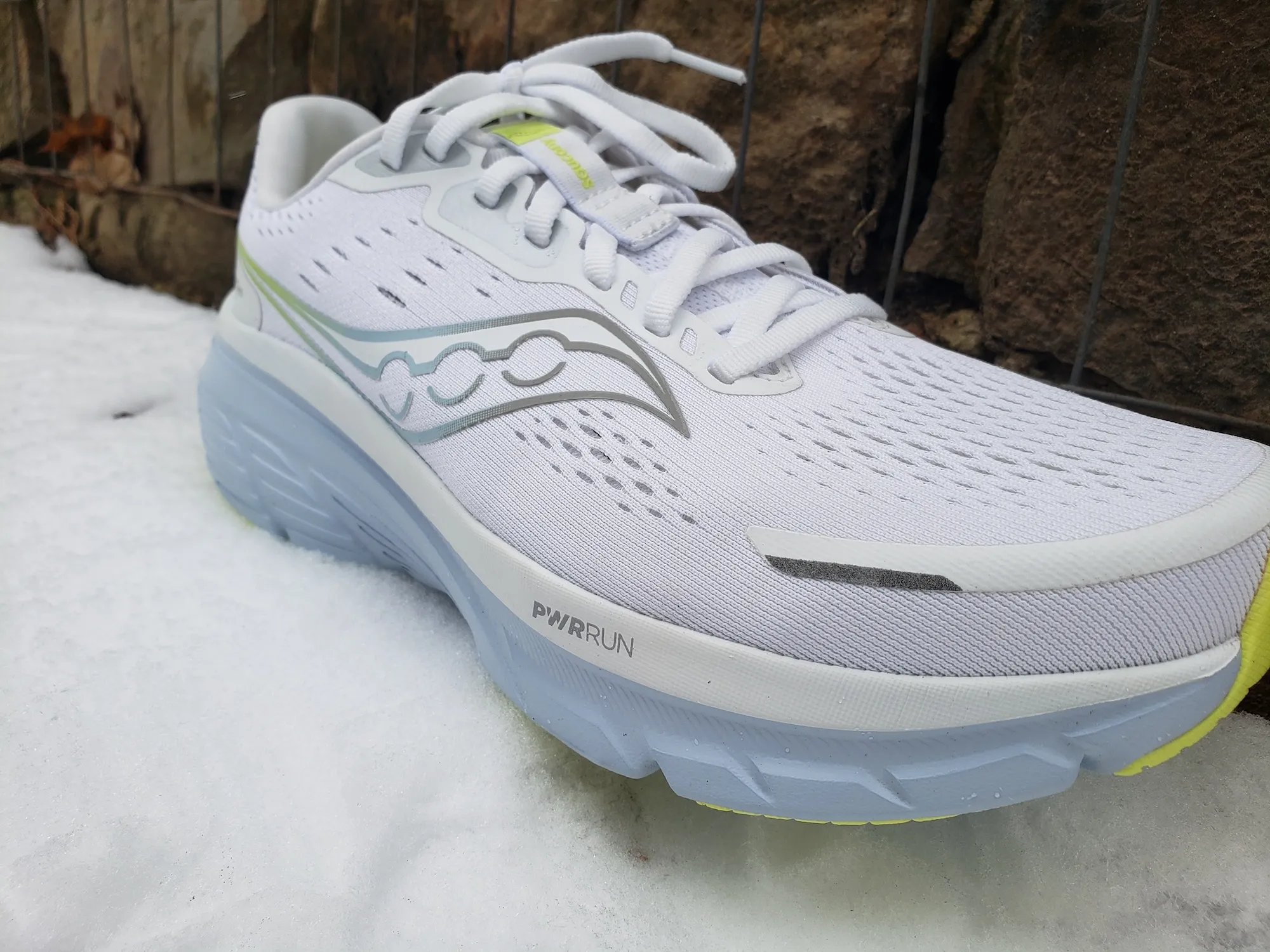
The upper of the Saucony Guide is made of breathable mesh material that offers flexibility and a secure fit. Moving slightly away from past posts to provide stability is their new Hollow Tech medial support. The TPU medial support element placed in rear of the midsole provides support without the rigid and firm feeling of a medial post, seen in most shoes.
- Weight: 9.6 oz Men’s, 8.6 oz Women’s
- Heel Drop: 6 mm
- 13 Colors for Women’s, 12 for Men’s
- Available in wide and extra wide
- Available on Saucony.com for $140
Checkout my comparison of the Saucony Guide vs Ride a these two are often confused for each other,
Neutral Running Shoe
👉Brooks Ghost V 17
The change our team is most excited about is in the heel to toe drop.The Ghost 17 is a neutral running shoe now with a 10mm heel to toe drop.
It’s not a huge difference, but if the 12 mm felt too high, you’ll really appreciate this. Plus, the lower drop will make a difference in potentially reducing knee pain or IT Band issues that often pop up with newer runners.
The second change that you may notice if you’ve worn previous models is from the cushion in the midsole. Brooks still uses its DNA Loft v3 foam but added more nitrogen in the forefoot (3mm) and heel (1mm) for a more cushioned and snappy feel underfoot.
The increase in stack height is actually why they changed the heel drop. It’s allowing for more stability in the shoe and ensures that you aren’t sinking to the ground as they keep adding cushion.
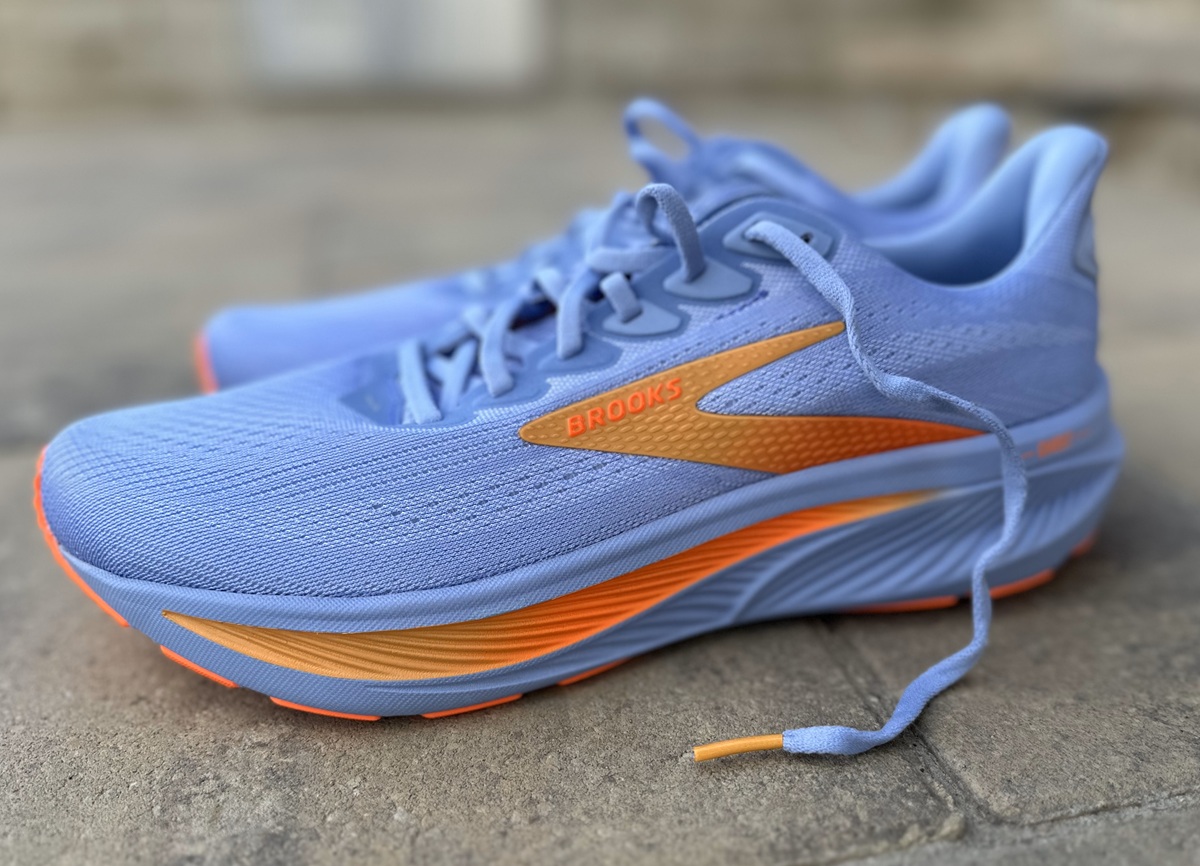
The Brooks Ghost 17 is a mix between soft and firm, like a shoe that you’d throw on when you want to hit party paces, but you also want to be able to get down to business.
They kept the same DNA Loft v3 foam but added more nitrogen to the heel and forefoot to give a little bit more of a pop and softer feeling underfoot. Now, there’s not enough pop that you’d grab these for a speed workout, or if you’re looking to run something like a fast 5k.
- Weight: 9.0 oz women’s, 10.1 oz men’s
- Heel drop: 10mm
- 6 colors available
- Available in Wide, Narrow and Extra Wide in select colorways
- Available from Brooksrunning.com for $150
- See our full review of the Ghost 17 here >>
Saucony Ride or Saucony Kinvara
These two are the most popular neutral running shoes from Saucony. Both have been around for many years and continued to improve.
What’s the difference in the Ride vs Kinvara?
- Cushioning is thinner on the Kinvara making it often more suitable for half marathon and under
- Kinvara is often seen as your tempo run or race shoe, the Ride your everyday training
The Ride is focused on cushioning and support, while the Kinvara is designed for a more natural and lightweight feel.
👉Saucony Ride 18
The Saucony Ride is a versatile neutral running shoe that provides a smooth ride for runners. It is designed for runners who want a neutral shoe with moderate cushioning, a responsive ride, and a comfortable fit.
If you already know that you want MORE cushion then the Triumph is going to be your neutral shoe of choice. Of the three, it’s the shoe that I recommend most for long distance runners.
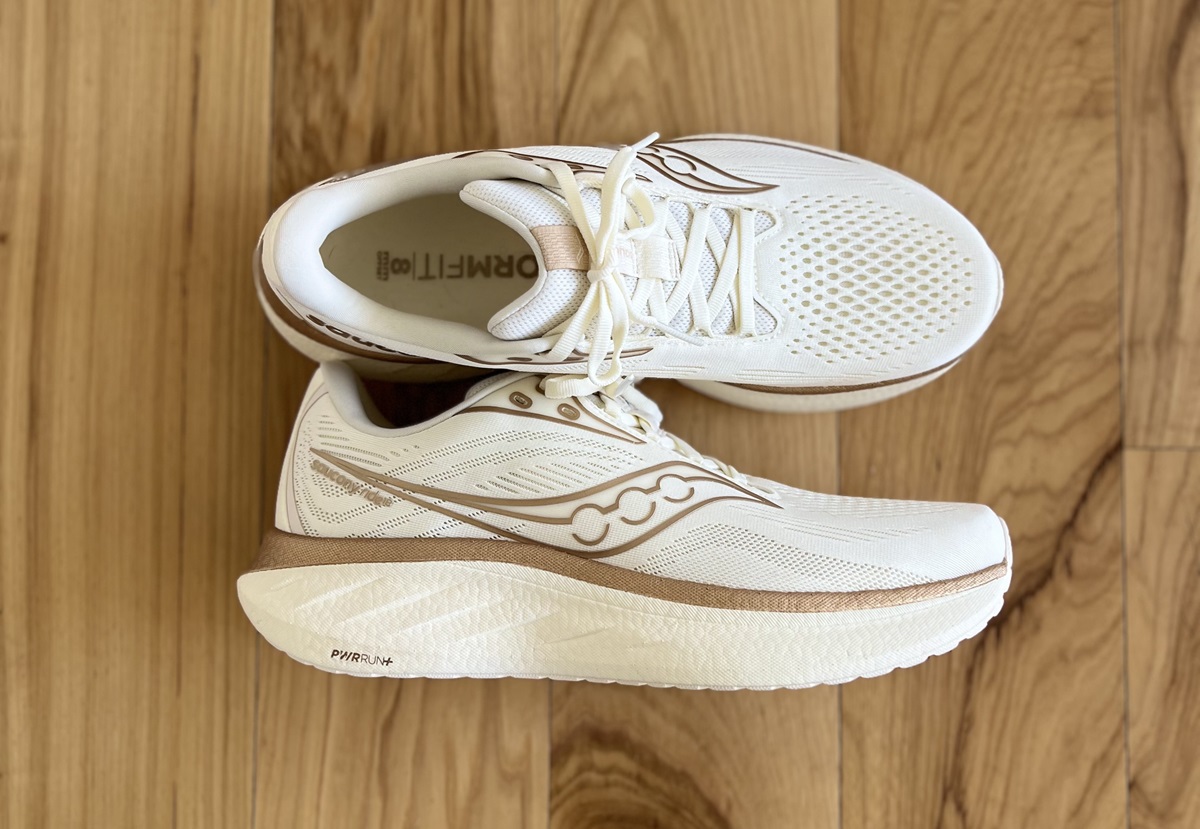
It’s not flashy, it doesn’t have huge selling points, it’s just a trainer that feels pretty nice and will last!
While it’s not a stability shoe, we’ve always found the Ride to have some elements which inherently make it feel more stable.
You could certainly do some speed work in this shoe, but it’s probably not what we’d reach for on those days. It doesn’t feel fast, but you aren’t held back by mounds of cushion either. Again, it reminds us of what ALL running shoes used to feel like, but with nicer cushion.
- Weight: 9.1 oz Men’s, 8 oz Women’s
- Heel drop: 8mm
- 15 colors available
- Available in Wide
- Available at Saucony.com for $140
- Read our full review of the Saucony Ride 18 here >>
👉Saucony Kinvara 16
This has been one of my go to shoe’s for many years. The newest model is taking some steps back to what the shoe was with a great cushion, but not overly built.
The stack height has increased to add more cushion and stability to the run, but as you can see they are holding on to that lightweight and low drop. It’s hard to find low heel to toe drop shoes, so this is a big time winner.
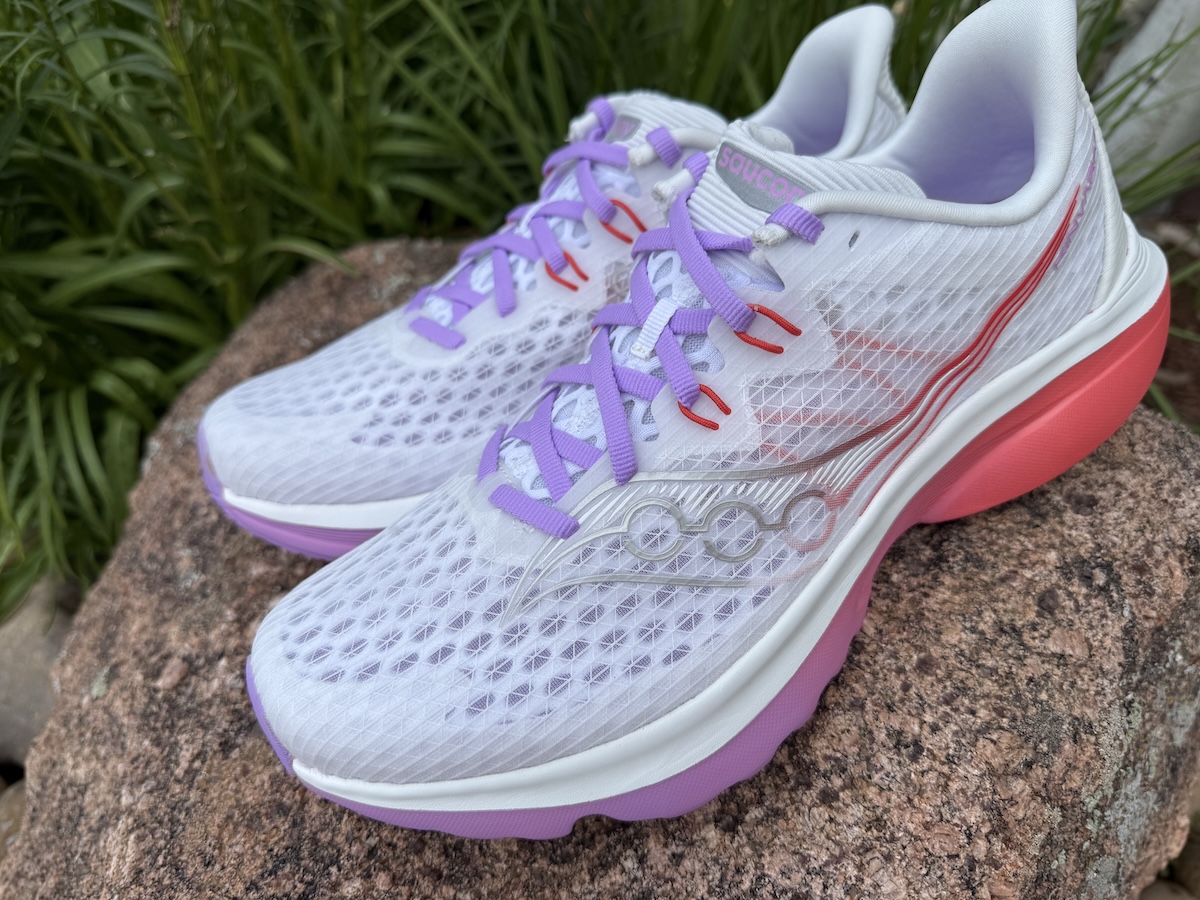
The shoe’s upper is made from a breathable mesh material that allows for maximum airflow and helps to keep feet cool and dry. This one has a bootie style fit, meaning that the tongue is attached. I LOVE this because it means it’s not going to be moving all over while I run.
- Weight: 7.0 oz Men’s, 6.2 oz Women’s
- Heel drop: 4 mm
- 8 colors available
- Available in wide
- Available now on Saucony.com ($130)
- Read our full review of the Saucony Kinvara 16 here >>
Cushioned Running Shoe
👉Brooks Glycerin 22
The Glycerin remains one of Brooks most loved running shoes. I told you I ran a marathon in it! It‘s a great all–around running shoe, providing great cushioning for a variety of running distances.
Brooks slightly changed things and use their DNA tuned foam underfoot. This EVA foam is the most durable and allows for a lot of softness. With their DNA tuned technology they can change the softness in different areas of the shoe based on usage type. In this case, a go to daily trainer.
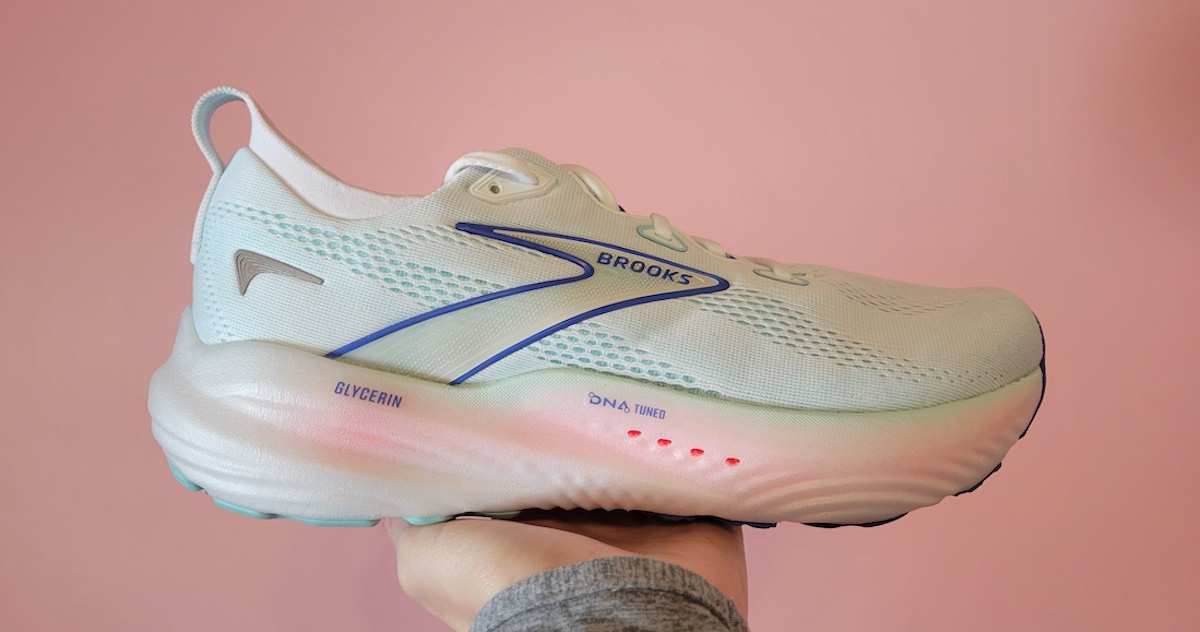
- Weight: 10.2 oz Men’s, 9.1 oz Women’s
- Heel Drop: 10 mm
- 9 colors available
- Available in Medium, Wide and Extra Wide (wide and extra wide widths available in select colors)
- Also available as the very popular Glycerin GTS for stability lovers
- Available on www.brooks.com for $165
- Check out our full review of the Brooks Glycerin 22 here >>
👉Saucony Triumph 23
I’ve used the last few models of the Triumph for MANY training miles and definitely recommend.
The Saucony Triumph is known for its plush cushioning, which you can absolutely feel more than in the Saucony Ride. The foam combo makes it durable. The lower stack is more comfortable for so many and now they lighter weight is an added bonus on those long run days.
It’s a shoe that the middle and back of the pack can happily wear on half marathon and marathon race days!
While it’s by no means a speed shoe, the foam used does help with energy return compared to other big plush cushioned running shoes.
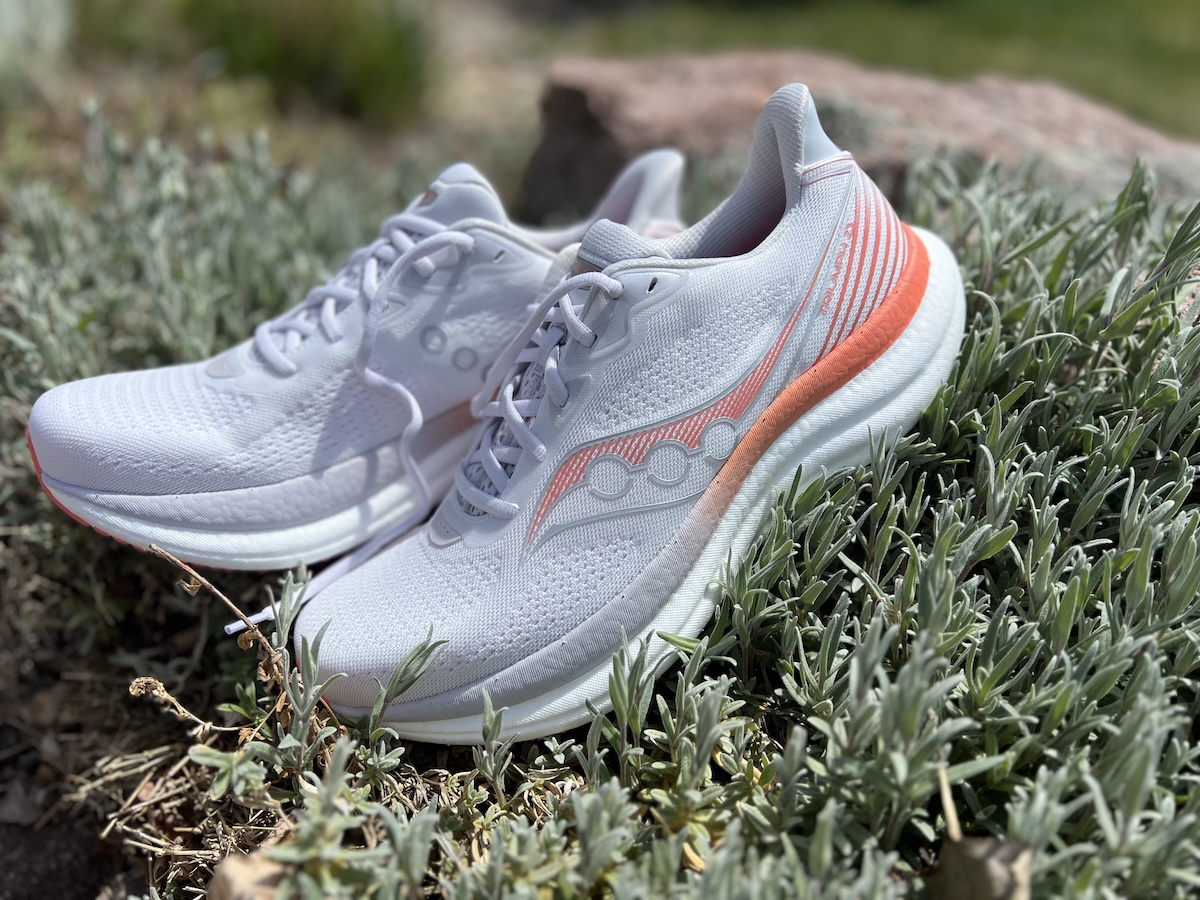
Whether you’re heading out for a 5k or your 20-mile long run, this shoe provides the comfort and support you need, especially on the days when your legs are feeling it a bit more than usual.
- Weight: 9.2 oz men’s, 8.4 oz women’s
- Heel drop: 10 mm
- Stack: 37 mm
- Available in 10 colors
- Available in wide
- Available now on Saucony.com $160
- Check out our full review of the Saucony Triumph 23 here >>
Carbon Fiber Plate Shoes
Are they cool new technology, yes. Do they last as long as your other shoes, nope.
So if you want to test these out use them for speed work and then race day! Watch my detailed video on how Carbon Fiber Shoes work.
👉Brooks Hyperion Elite
The Brooks Hyperion Elite is a lightweight, high-performance running shoe designed for speed and efficiency. It’s doesn’t have a full solid plate like we see in other Super Shoes and the reasoning behind that is both to keep the shoe lighter and only provide stability to the cushioning not dampen it.
SpeedVault Race+ plate has been “fine tuned” so that the plate is actually different based on the size of the shoe and thus meeting the needs of that runner. The larger the shoe, the stiffer the plate in essence.
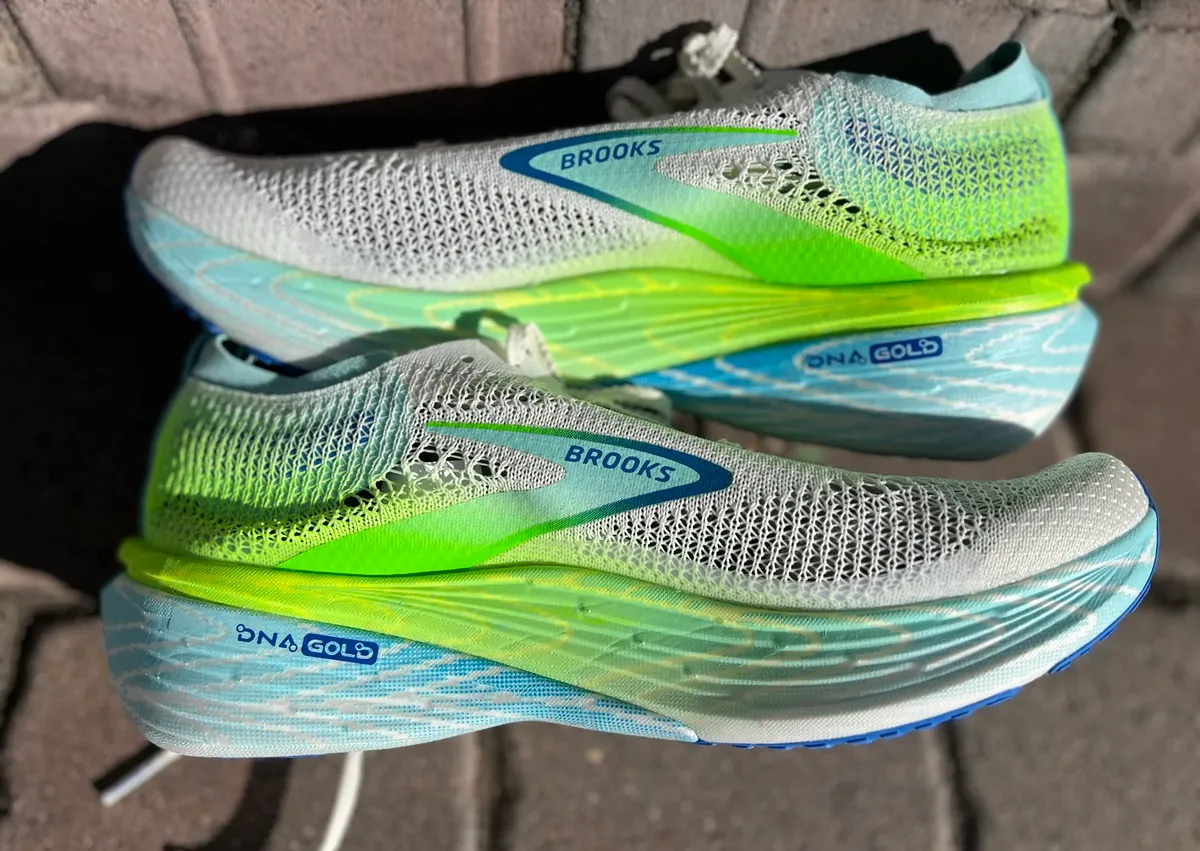
Now they are using what they call DNA Gold 100% Super Critical PEBA foam, instead of Super Critical EVA. This helped to drop an entire oz of weight from the shoe, but more importantly changed the feel underfoot.
- Weight: 7.4 oz men’s 10.5 (Unisex sizing)
- Heel drop: 8mm
- 1 color available
- Not available in Wide
- Available at BrooksRunning.com for $250
- Check out our full review of the Brooks Hyperion Elite 4 here >>
👉 Saucony Endorphin Elite 2
While it moves away from the firm, snappy ride of its predecessor, theSaucony Endorphin Elite 2 delivers bounce you feel in every stride, combining exceptional speed and comfort to make it a standout choice for your next race day.
Designed to help runners unlock their speed, the Saucony Endorphin Elite 2 is a bouncy, high-performance supershoe built for half-marathon to marathon distances. Its standout feature is Saucony’s incrediRUN foam, which delivers insane energy return and next-level cushioning—exactly what you want on race day.
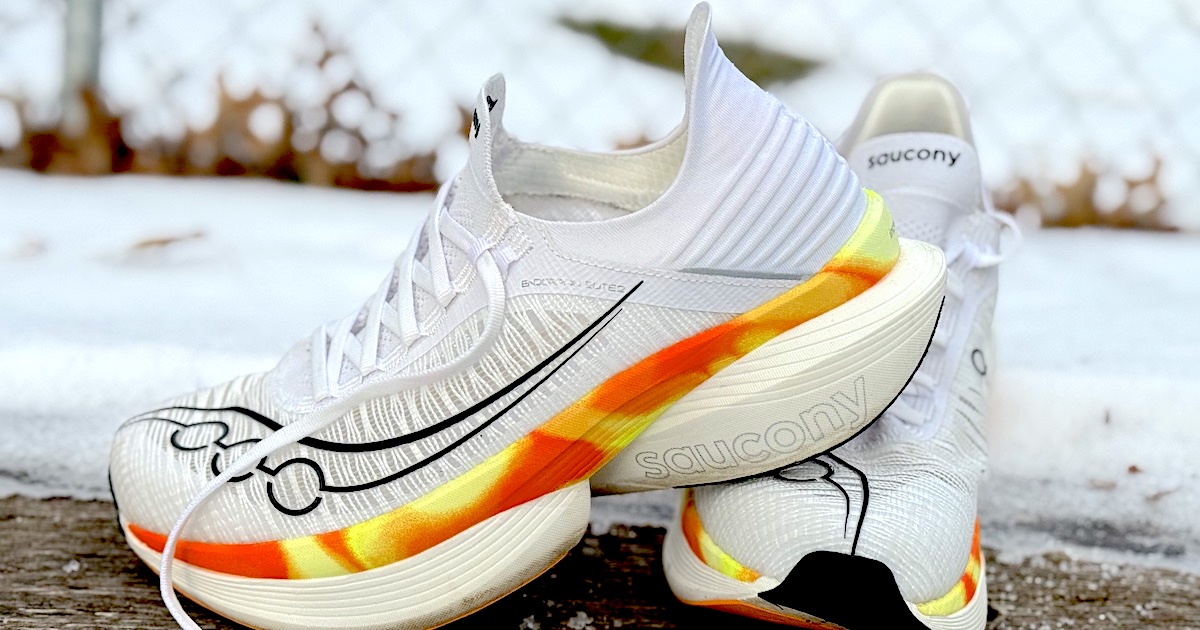
- The shoe strikes a fine balance between comfort and performance, making it a frontrunner (sorry, not sorry for the pun) for those who crave a softer, more energetic ride.
- Weight: 7oz Unisex sizing
- Heel drop: 8mm
- 2 colors available
- Not available in wide
- Available at Saucony.com for $275
- Read our full review of the Saucony Endorphin Elite 2 here >>
Trail Running Shoe
👉Brooks Caldera 8
It’s been a few years since I’ve run in this particular model, but I really enjoyed it at the time. I’ve just been testing a lot of other shoes!
When you first look at these shoes, your eyes are probably immediately drawn to the amount of foam. But don’t worry, this doesn’t translate to the Caldera 8 being a super squishy ride. The cushion is there to help protect your feet from rugged trails. But the trade-off is that it’s missing some of that responsiveness to help you pick up the pace.
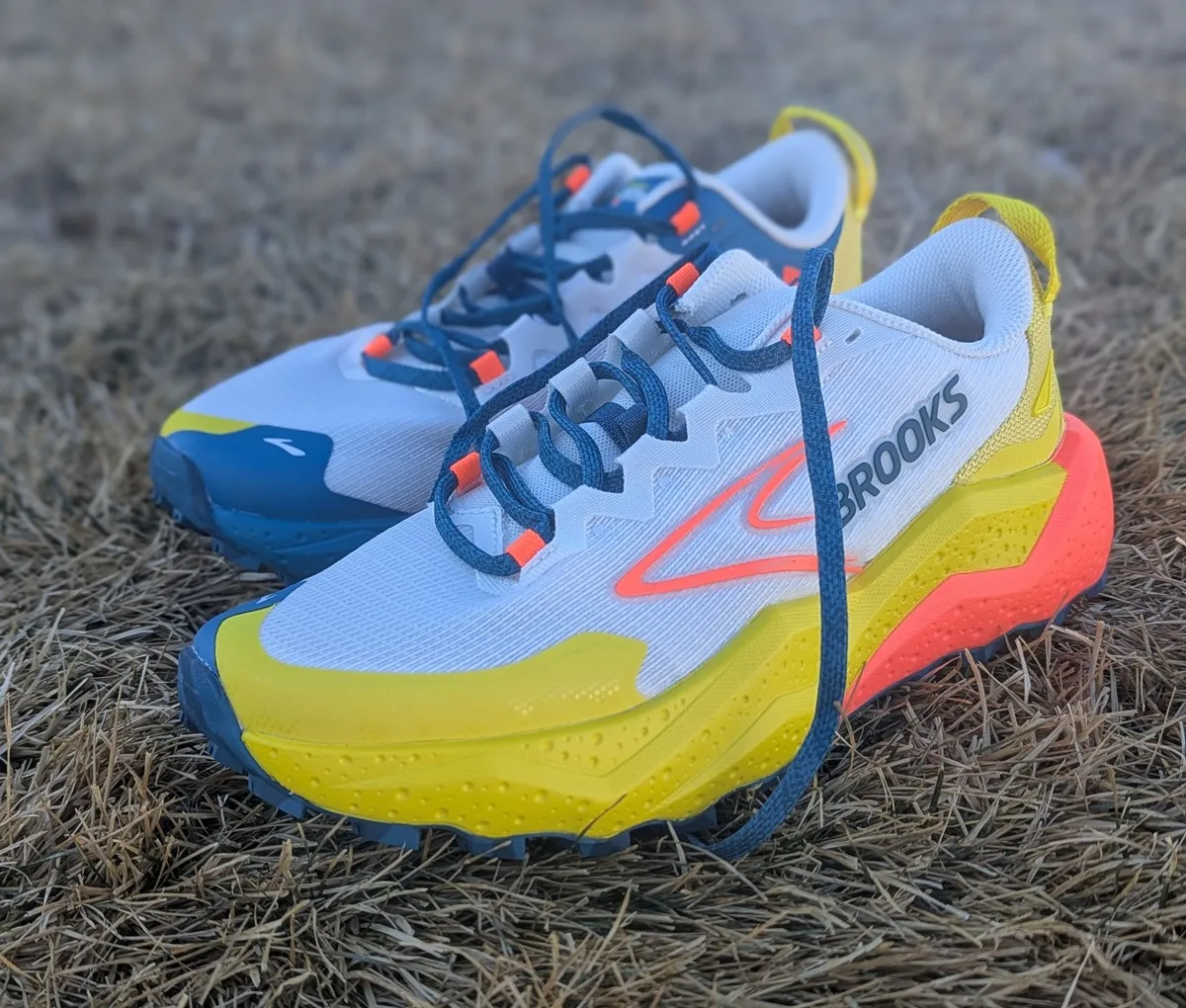
The DNA Loft v3 foam brought the cushion but was still firm and bouncy enough to feel connected to the trail. With all the cushion the Caldera 8 was still stabilizing, flexible, and responsive enough to handle the most poorly chosen line through roots and rocks.
This is a perfect match for trail and ultra runners looking for a little extra cushion while spending lots of time on the trails.
- Weight: 14.4 oz Men’s, 9.3 oz Women’s
- Heel drop: 6 mm
- 2 colors
- Not available in wide
- Available from Brooksrunning.com for $150
- Read our full review of the Brooks Caldera 8 here >>
👉Saucony Perigrine
This has been a trail running shoe that myself and other testers have loved for years. They had a few misses around model 10, but since then we’ve gotten back on track!
It’s slightly more narrow fit than some other brands, which works for some of us.
I always feel really confident in the traction of this show and I like the light guard just above the cushion to keep my toes from being wet in the grass or light snow.
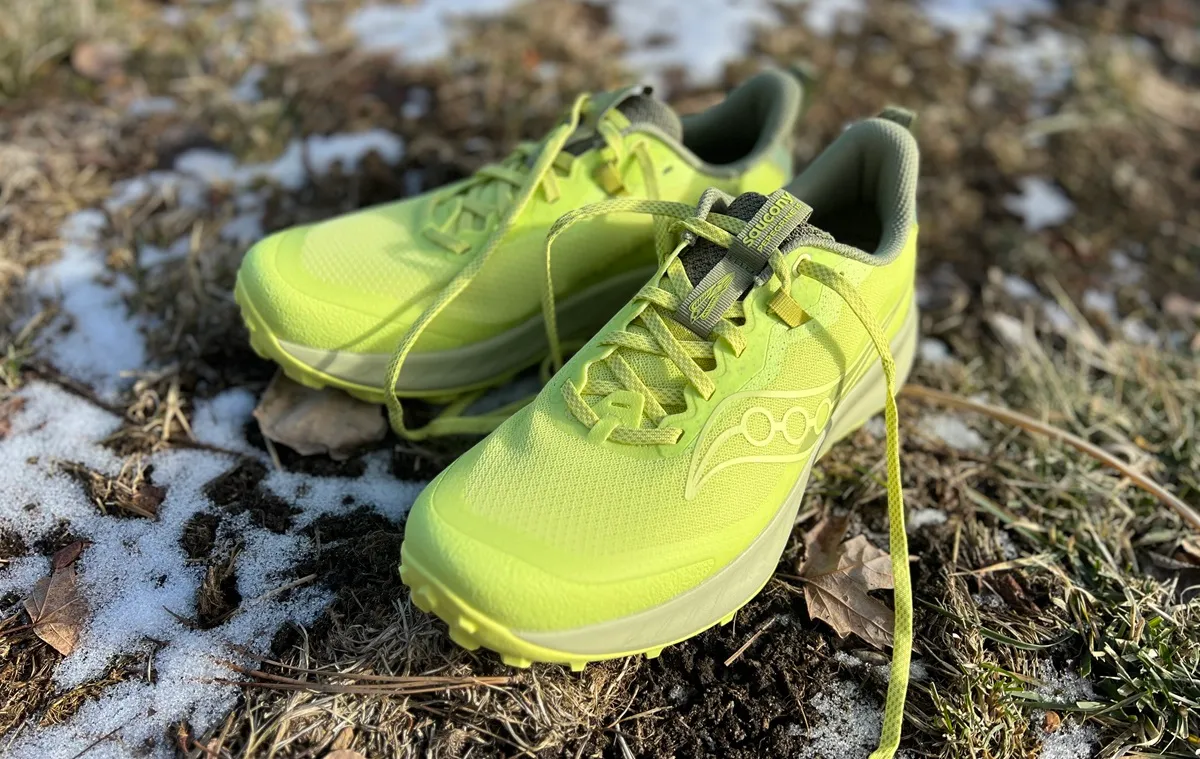
The Saucony Peregrine is a popular and versatile trail running shoe that has gained a strong reputation among trail runners and outdoor enthusiasts. Designed to handle a variety of terrains and conditions, the Peregrine combines responsiveness, durability, and traction to provide a reliable and enjoyable off-road running experience.
For me, I appreciate that it’s not one of the overbuilt trail shoes and the traction is fabulous. They have also taken some weight out of the updated models!
BONUS this is a lower stack height than so many of the current shoe trends and many prefer that on the trails to feel more stable.
- Weight: 9.7 oz Men’s, 8.7 oz Women’s
- Heel drop: 4 mm
- 5 colors available
- Available in wide
- Available at Saucony.com for $140
- Read our full Saucony Peregrine 15 review >>
Checkout my complete breakdown of the best Saucony running shoes >>
What about the Endorphin Line?
Because Saucony really shook things up introducing a whole new line of shoes, it feels like there needs to be at least some discussion here!
One of the big things they talk about is the Speed Roll to help roll your foot forward, which is actually pretty similar to the rocker that Skechers put in their running shoes from the start.
- Endorphin Pro 4 – Designed for speed with the carbon fiber plate, this is your race shoe. It’s a winner.
- Endorphin Shift 3 – This feels like a cushioned slightly stabilizing shoe, good for everyday training. It’s not been my favorite Saucony shoe and I tend to like most of their shoes.
- Endorphin Speed 3 – Also designed to be a neutral, cushioned shoe you can take to the race, but without the carbon fiber plate, as it uses a nylon plate instead.
Are carbon fiber plates everything?
Some runners have found injury using them and since the shoes wear out faster, you are only doing a few training runs in them prior to race day. But…the data does shoe there are some speed benefits! So it’s really up to you.
More About Brooks
Believe it or not, Brooks started out in 1914 making ballet slippers and bathing shoes. Since then, they have made everything from baseball and football cleats to roller skates.
It wasn’t until Frank Shorter won the marathon at the 1972 Munich Olympics that Brooks considered limiting its focus. The first running shoe debuted in 1974 and their most popular running shoe, the Adrenaline GTS first hit the market in 1999.
In 2001, Brooks decided to focus solely on running.
They introduced the Transcend in 2013, a shoe that used new biomechanics technology to create a GuideRails technology, allowing runners to run naturally without trying to correct their gait.
The Seattle-based company is also well known for its commitment to sustainability and giving back. Brooks donates time, gear, and money to companies that align with their values around diversity, equity, and inclusion and staff receive paid annual volunteer time.
Your gait and feet will likely change over time and you may need to change shoes.
This is also why I recommend rotating through several pairs of shoes at once.
And remember, just because these are two of the most well known brands on the market, there are still plenty of other shoe brands to select from if neither Brooks nor HOKA has the right shoe for you.
Keep in mind that shoe design can change, even with the same model, so always assess how the shoe fits every time you replace a pair.
More about Saucony
Like another well known running brand (New Balance), Saucony started it’s first factory in 1898. And by 1910 they were making running spikes…but few people were running or even looking for running shoes, so it wasn’t until the 1970’s that they started to grow.
First they became known for their casual shoe with it’s cool style and then, the big time hit.
Runner’s World featured them in 1979 as a top 10 running shoe. By the 80’s they were making shoes with a non-slip sole which was a big innovation.
Then came 2009 and the Saucony Kinvara – this one shoe changed many things about their design and philosophy. It was the more natural running shoe (yes during the barefoot trend). The new goal became how to strip shoes down, without sacrificing cushion and comfort.
Good performance, good health and good community are their guiding principles. You may have seen their hashtag #runforgood – which is really about doing good, giving back and finding sustainable practices.
For more help selecting the right shoe for you, don’t worry, I’ve got you:
- Best Trail Running Shoes
- Top 5 Marathon Running Shoes
- Skechers Running Shoes review (you might be surprised!)
- Best Running Shoes
Other ways to connect with Amanda
Instagram Daily Fun: RunToTheFinish
Facebook Community Chatter: RunToTheFinish
Sign Up to Receive a Weekly Newsletter with Top Running Tips and Laughs




This is a great review, thank you! I’m a long time sponsored Brooks athlete, but I still enjoy learning about other running shoe brands and the various benefits each brand offers. I am wondering, is there a reason that you did not include Brooks’ carbon plated shoe, the Hyperion Elite? Thanks again.
This is really interesting! Thank you for the very detailed comparison.
I’ve been wearing Kinvaras for many years but am currently dabbling in other options both by Saucony and other brands. I’d always written off Brooks because I’ve heard it suits a narrow foot so it’s very interesting to see your point about the wider toe box. I’ll definitely give them a try on my next visit to the shoe store.
I’m happy to see that I’m not the only person who has focused my attention specifically on these two brands. I can never decide whether my favorite shoe is Brooks Ghost or Saucony Ride, so I always have one pair of each on hand, and tend to alternate between the two. As long as I mix it up a bit between these two, I don’t get in a rut and I seem to be able to run without pain.